| 1 | A mostly harmless branch clinger |
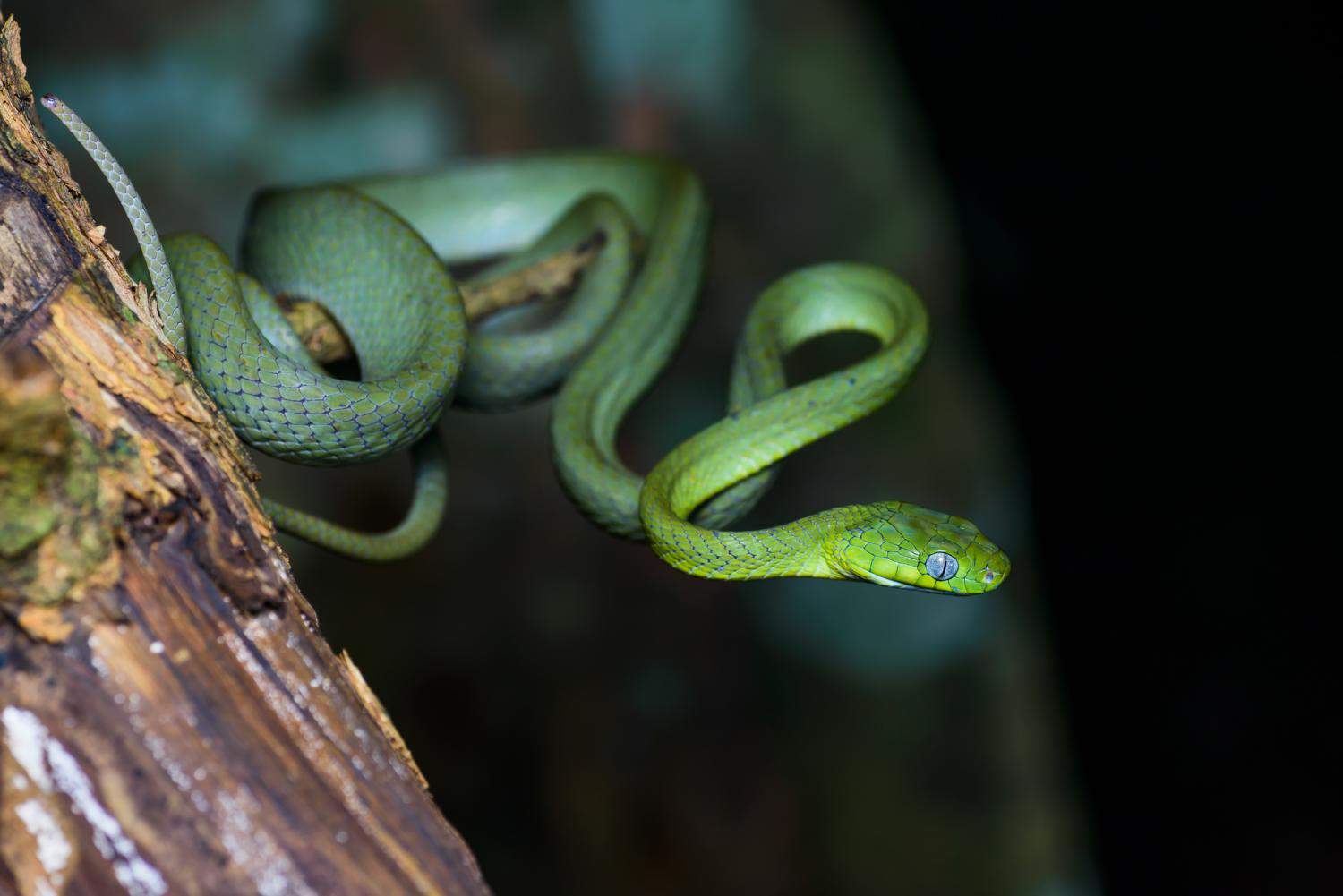
In Thailand, a green snake resting on a tree branch can mean an imminent injection of severely cytotoxic venom, if it’s the country’s staple white-lipped pitviper. Alternatively, it might be a more harmless branch dweller – the green catsnake. This is a close relative of the brown tree snake (Boiga irregularis), the Australian species which has invaded Guam and devoured most of the native birds there.
Green catsnakes (Boiga cyanea) are one of the most commonly encountered species in Thailand by ordinary people, appearing in housing developments and even people’s front porches. The Boiga catsnake family has 42 members, and green catsnakes are the most wide ranging of all. Their empire spreads from India through Bangladesh, to Thailand, Cambodia and Vietnam.
Green catsnakes have only a mild venom which has never been recorded to kill a person. Instead, their defensive strategies are geared towards looking as mean and intimidating as possible. When feeling threatened (whether justified or not), the green catsnake will curl up into S-shaped coils, thrash its body wildly, strike at the enemy, and gape its mouth while peeling its frenzied eyes wide open to look truly demented. A special feature is a black inner mouth, but green catsnakes hiss less commonly than some snakes. Unlike the painted bronzeback, another common Thai snake, they rarely dart away into the bushes in a panic.
| 2 | Confident around people |
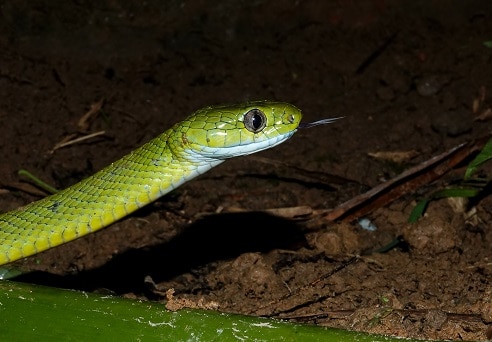
Green catsnakes are tree-dwellers, but tend to avoid the densest forests where cunning pitvipers lurk and explorers hack their way through with machetes. Green catsnakes prefer evergreen forests, and open areas with a healthy mixture of tree clumps and bushes, including agricultural areas.
In Thailand, they’re abundant in rice fields, rubber and fruit plantations, and cattle grazing fields converted from former rice fields. They’re extremely rare in fully-fledged rainforests and normally appear at low altitudes, below 2000 metres above sea level. Green catsnakes cope well with areas controlled by mankind, even thriving in them, particularly lurking on the edges of bushes.
When climbing trees, green catsnakes generally stick to branches 1-2.5 metres above ground. Coincidentally, this is the perfect height for making villagers jump back in fright, possibly because they’re mischievous and love scaring people. It’s also the perfect height for resting in the straw roofs of wooden agricultural huts, which they have no problem dropping out of casually, landing on people’s heads.
| 3 | Hidden tinges of blue |
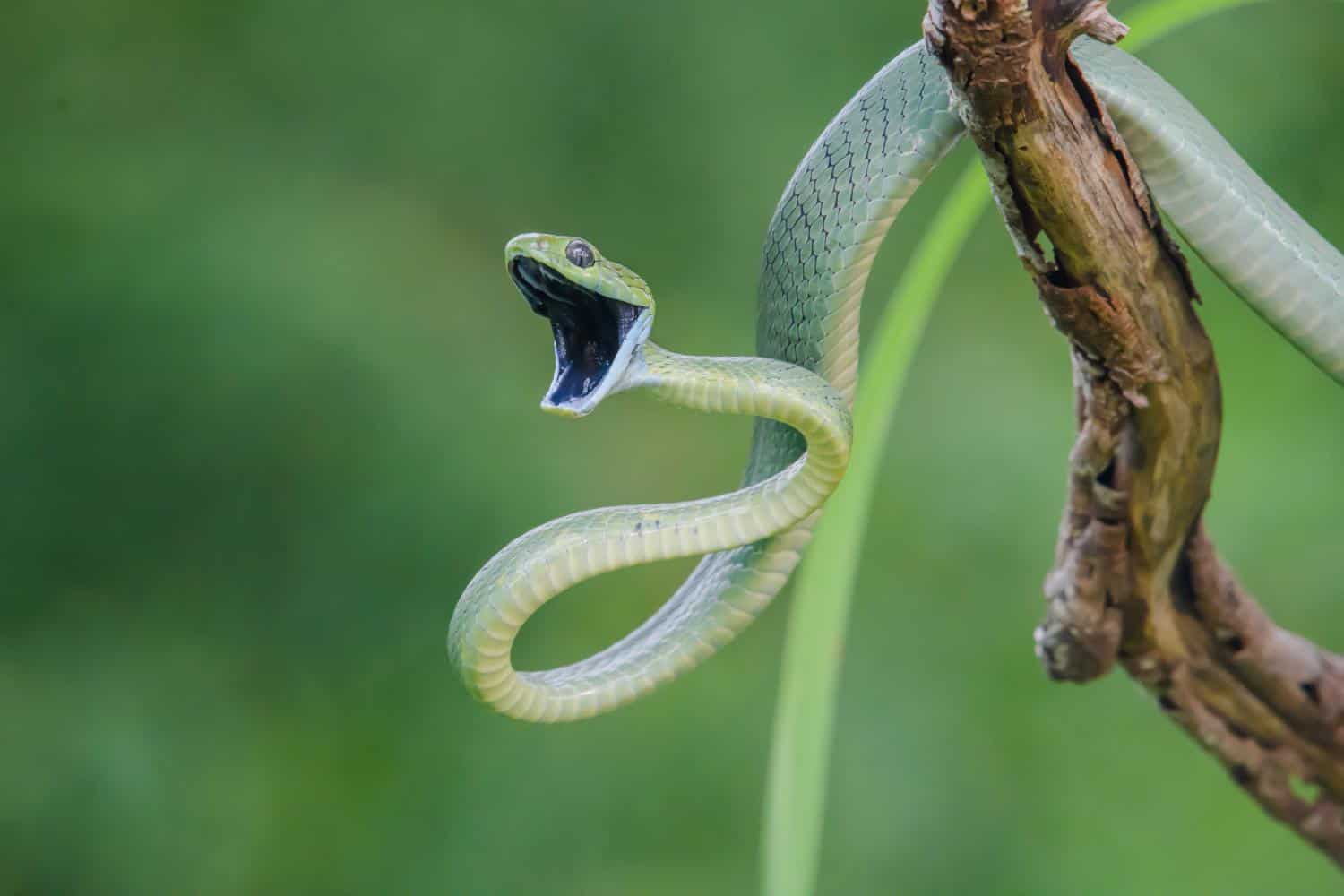
Boiga cyanae are overwhelmingly green from a distance, but more subtle colours appear as you inch closer on tiptoes, hoping that they don’t notice. Their belly has a white colour, often with green or yellow tinges. Between each scale, dark skin is visible, and their chin is the most interesting, with an electric blue colour, covering approximately as much space as a man’s unshaven stubble. Their eyes are grey, often with a slight blue tinge.
As youths they’re wildly different, an orange-red to brown shade. The change begins with their head, with the green blooming almost overnight, and spreading gradually down their bodies. It’s common to observe half and halfs, split between a green head and a red body. Green catsnakes have large eyes as adults, but as hatchlings they’re particularly bulging and bulbous.
Females are larger in Boiga cyanae, pushing to a maximum of 184cm. Males reach a perfectly respectable 140cm, and also have a thinner body relative to length. This might sound disappointing for the snake, but they’ll soon realise better: thinness equals a superior ability to skirt over branches, vanishing to a shadowy tree trunk hideaway.
| 4 | Venom: deadly or just itchy? |
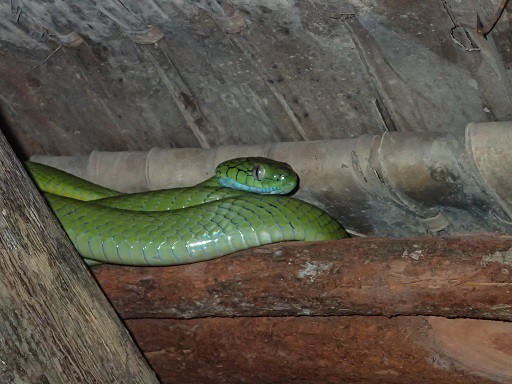
Green catsnakes have a mild venom, which is optimal for subduing small lizard prey, rather than taking down a bodybuilder or a fully grown bull. There are few confirmed reports, but a handful of fellow catsnakes have turned out to be nastier than originally thought. The black-headed catsnake (Boiga nigriceps) recently had three-finger neurotoxins discovered in its venom.
One report happened in April 1984, when a 120cm green catsnake struck a 155cm green catsnake in the same cage. The attacker held onto its victim for several minutes before the snakes were seperated. 2 hours later, the bitten snake suddenly became lethargic, with muscular weakness. This worsened over the next day until the snake finally died, 30 hours post bite. This tale also proved that unlike some species, green catsnakes have no resistance to their own venom (which rules out biting themselves to scratch an itch).
All evidence suggests that its venom is neurotoxic, but in a very mild form. Boiga cyanea injects venom through its rear fangs, which are trickier to angle than a cobra’s. In fact, they lack front fangs altogether.
| 5 | Some aggressive, others calmer |
Keepers testify that green catsnakes have variable personalities in captivity. Some are alert and defensive, but calm down as they grow used to your reassuring presence, while others are laid back and cool from day one. A handful are vicious demons which never accept your authority.
Great fear orbits this (mostly) harmless species in Thailand, mainly because of their superficial resemblance to venomous pitvipers such as Trimeresurus albolabris. One episode happened at a solemn Buddhist funeral. The monks were reciting prayers, when a green catsnake poked its head out from beneath the podium they were sitting on. The funeral guests on the front row broke out in panic, and soon everyone was fleeing. Even the monks themselves preferred to flee, before the confused green catsnake turned around and vanished into the darkness. Who knows – maybe the deceased had saved the catsnake from a king cobra one time.
Meanwhile, one of the green catsnake’s closest relatives within the family is Boiga saengsomi, an inhabitant of southern Thailand.
| 6 | Prefers branches 3 metres high |
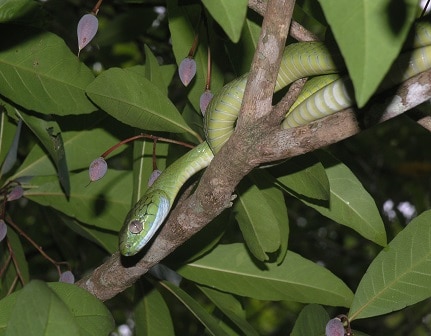
Green catsnakes are a fairly active and adventurous snake, a forager rather than a stationary ambusher. They’re a nocturnal species, which spends most of the day coiled around their branch calmly, waiting for the pesky sun to get below the surface.
Twilight and night is when they kick off, usually between 18:30 and 19:00 in southern Thailand, for example. Green catsnakes move 55 metres in the average 24 hour period, and males move 2.5 times further than females.
The same study also found that when sighted in branches, green catsnakes rest an average of 3.3 metres off the ground. With ground sightings added to the data, their average branch perch height was 2.11 metres. The green catsnake was never observed on branches above 10 metres. They stick to lower levels than fellow branch dwellers such as green tree pythons. They’re often forced to the ground in times of heavy rains.
| 7 | Eats reptiles if possible |
Green catsnakes have a flexible diet, but reptiles are their favourite. One snake expert analysed 43 green catsnakes from the Thai province of Sutthani, and found that their top prey species was the oriental garden lizard (Calotes versicolor). This is an extremely common reptile averaging at 10cm long, often found in parks and on the edges of forests. They live in low shrubs and bushes, where they’re often spotted by passers-by scampering away.
Oriental garden lizards are hunted by many Thai snakes, including Asian vine snakes, and can be so common in parts of Thailand that one lizard is found on every bush. Consequently, green catsnakes have a bountiful food supply to indulge in. They also eat many-lined sun skinks, and were originally thought to be a specialised snake swallower.
In captivity, they’ve successfully been fed striped kukri snakes, white-lipped pitvipers, and Malayan pitvipers. Keepers testify that feeding them mice can be difficult. They often keep defrosted hairless pinkies in their mouth and spit them back out again with a look of annoyance. Others have succeeded in attuning them to mice by scenting them with a handy lizard, luring the catsnake in by stealth.
| 8 | One of Thailand’s top bird snatchers |
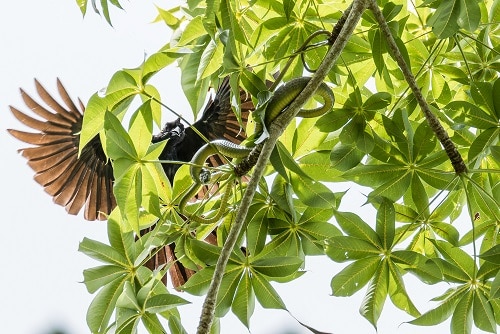
Boiga cyanae also has a particular taste for birds, being such an addict that it accounts for 22-33% of all bird predations in northeast Thailand. An Amazon tree boa waits on a low branch in ambush, but the green catsnake is a little different. It actively seeks out bird nests at night, perched in tree hollows, and raids them while the family sleeps. This includes the bird hatchlings and even the eggs.
A study from Sakaerat Biosphere Reserve, rich in evergreen forests, found that their favourite bird species were the white-rumped shama and scaly-crowned babbler. These are in the perfect range for green catsnakes, as the former builds its nest 2.32 metres above ground on average, and the latter 0.98 metres. Surveys have even found that green catsnakes rev up during the nesting season, moving an extra 50 metres per day. The only comparable snake in Thailand for nest raidings is Blanford’s bridal snake.
Another study examined an evergreen forest in northeast Thailand. It found that two predators were most responsible for raiding bird’s nests: the northern pig-tailed macaque (43.7% of raidings) followed by the green catsnake (21.8%).
| 9 | Impervious to speeding traffic |
The screeching tyres of cars are a serious problem for many snakes. Corn snakes, gopher snakes, and smooth green snakes are species which are commonly found on roads, with a single gruesome tyre mark across their body, surrounded by gore. But green catsnakes have the power of being magically immune to this. A study from Lawachara National Forest in Bangladesh examined a 7km stretch of road, discovering 700 road-killed snakes over 14 months, including 29 snake species in total.
Yet the scientists failed to find a single dead green catsnake. This could have been because they were rare, but when the researchers explored the surrounding forest at night, green catsnakes were abundant, happily weaving along the branches, oblivious to the motor mayhem happening below. It’s not like they’re an exclusive branch dweller either, as green catsnakes often drop to the ground to hunt. It’s possible that they simply dislike tarmac.
This shield has one disadvantage, however. It means that when forests are divided by logging, or fresh road construction, isolated pockets of green catsnakes could be unable to replenish each other, putting each one at higher risk of endangerment. Meanwhile, two of the highest ranking roadkill snakes were common mock vipers (Psammodynastes pulverulentus) and buff striped keelbacks (Amphiesma stolatum).
| 10 | Lays its eggs in hollow trees |
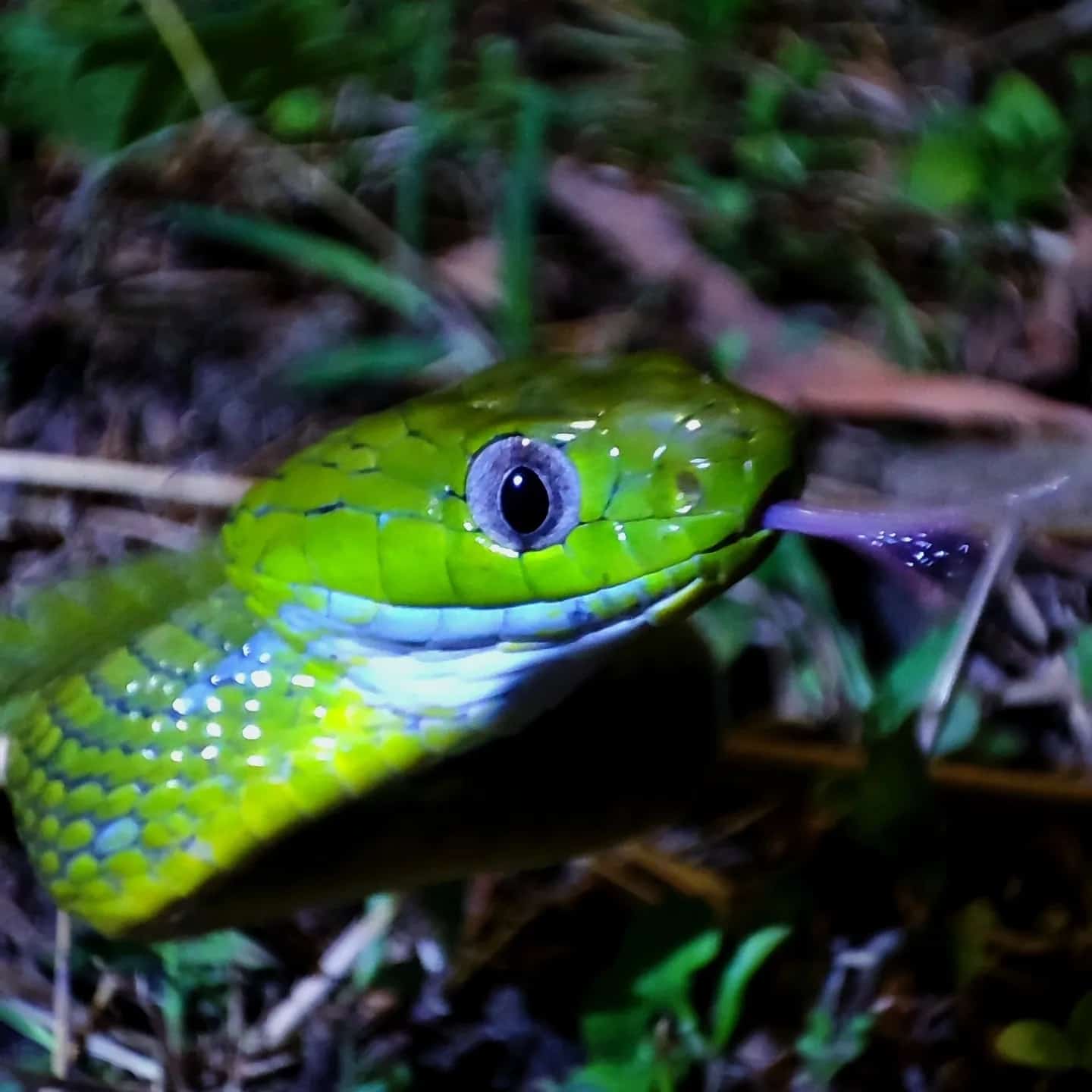
Green catsnakes are extremely widespread and successful, the envy of snakes everywhere (particularly the Lake Buhi bockadam, which lives in a single lake in the Philippines). One reason is that they have two breeding seasons, taking place in April-May and then October. They thus have two egg-laying seasons as well, usually in June/July and then January.
The usual number of eggs is 3-10 with green catsnakes, nothing out of the ordinary. 13 eggs is the highest ever listed, compared to the mud snake which can lay over 100 young. The eggs are shaped like a tubular multivitamin capsule, but snowy white and far larger (and with more snake venom). The average dimensions are 4.5 by 1.5cm, with a weight of 9-10 grams.
The green catsnake prefers to lay its eggs in hollow trees, and forks in tree branches, covered with a bed of rotten leaves and swaying ferns. Keepers have noticed that they consistently attempt to climb up and lay their eggs above ground, even when the container floor is covered with perfectly suitable damp substrate.
